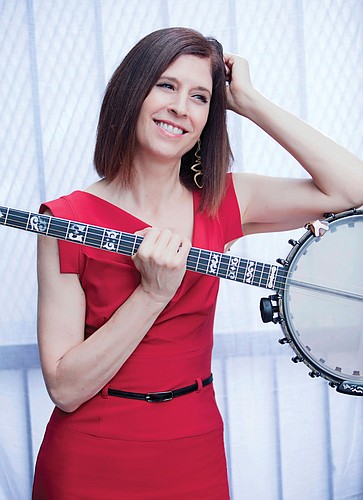- April 23, 2024
-
-
Loading

Loading

Cynthia Sayer grew up in a cacoon of music. In Scotch Plains, N.J., Sayer and her three siblings would experiment with instruments, filling the house with all kinds of sounds. Her parents, Bertram and Barbara Sayer, were an amateur painter/photographer and vocal choir singer, respectively, so the arts were a constant childhood companion.
“Honestly, I played a bunch of instruments growing up,” says Sayer. “I took viola at school. I took piano lessons since I was 6. I took some drum lessons at school. I was in the school orchestra and messed around with guitar.”
Throw in stints in summer and community theater and dance lessons, and then one has an impression of Sayer’s inevitable destiny in the arts. But it would be her serendipitous adoption of the banjo that would allow her to carve out a niche in the jazz and music world.
Imported from Africa and made popular in America in the 19th century in traveling minstrel shows, the banjo has a storied history in this country. Made popular in the Dixieland jazz halls of New Orleans and the bluegrass-covered hills of Appalachia, the banjo is a democratic instrument associated with the people. Sayer’s path with the banjo was predicated by her desire to play another African instrument: the drums.
“I saw the drummer at our school’s talent show, and I immediately wanted to play drums,” Sayer says.
But her parents said no way — the drums were too loud.
“One day I came home from school and there was a banjo on my desk in my room,” says Sayer. She was 13 at the time.
Sayer initially thought that the banjo, though fun to play, was mired in stereotypes. “Dueling Banjos” aside, the banjo was comical looking and sounding, and she couldn’t look past the instrument being synonymous with humor and kitsch.
It took two musicians to help Sayer see past the instrument’s whimsical reputation.
“My beginning banjo teacher, Patty Fischer, was from a different generation, and it was rare to encounter another female banjo player,” Sayer says. “I was so knocked out by Patty.”
And, in college, one of her colleagues played her a record from jazz musician Elmer Snowden.
“When I heard this record of a banjo playing with this intense swing, full of integrity and such a hot, driving instrument, I thought, ‘Wow, that’s what I want to do,’” Sayer says.
Since graduating from Ithaca College in 1977, Sayer’s rise in the professional music world has coincided with the popularity of her plucky companion. Having performed in Carnegie Hall, the Lincoln Center and even the White House, Sayer is one of the premier banjo players of her generation — she’s performed with Wynton Marsalis, Dick Hyman, Marvin Hamlisch and Wycliffe Gordon.
Sayer recalls a time in her late 20s when she told a woman at a party that she played the jazz banjo. “The woman didn’t know how to respond. She couldn’t react. It was just viewed as weird. But now if I go to any kind of gathering and they hear jazz banjo they think that is so cool, and I get barraged with a million questions.”
With her parents moving 10 years ago to Sarasota, Sayer finds comfort in playing shows here as part of her annual tour. Sayer flew into town earlier this week to spend time with her parents before her weekend performances at The Glenridge Performing Arts Center.
“It’s a very big thing for me to play in the area, and it’s fabulous that I feel I can go there for an annual tour,” she says.
BANJO BASICS
4, 5 or 6 — number of strings a banjo can have
The head — the large circle section covered in an animal skin or plastic membrane
Bass banjo — A massive, orchestral bass-sized upright banjo with three or four strings
OME jazz banjo — Sayer’s preferred banjo, which is a standard banjo without the short drone string